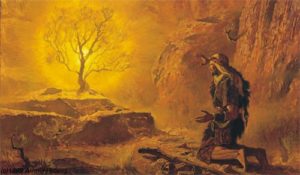Commemoration of Moses
September 4
The Lord be with you
 Moses was born in Egypt several generations after Joseph brought his father, Jacob, and his brothers there to escape a famine in the land of Canaan. The descendants of Jacob had been enslaved by the Egyptians and were ordered to kill all their male children. When Moses was born, his mother put him in a basket and set it afloat in the Nile River. He was found by Pharaoh’s daughter and raised as her son (Exodus 2:1-10). At age forty, Moses killed an Egyptian taskmaster and fled to the land of Midian, where he married and worked as a shepherd for forty years. Then the Lord appeared to him in the burning bush, called him to return to Egypt, and tell Pharaoh, “Let My people go, that they may hold a feast to Me in the wilderness” (Exodus 5:1). Though Pharaoh initially refused, after a series of plagues, he eventually gave in and, after the Israelites celebrated the first Passover, Moses led them out of Egypt. At the Red Sea the Egyptian army was destroyed by God, and the Israelites passed to safety on dry land (Exodus 12-15). At Mount Sinai, they were given the Law and erected the tabernacle (Exodus 19-40). The tabernacle remained the worship site for the Israelites until Solomon erected the first temple. Because of disobedience, the Israelites had to wander in the wilderness for forty years before entering Canaan. Moses himself was not allowed to enter the Promised Land, though God allowed him to view it (Deuteronomy 34). In the New Testament, Moses is referred to as lawgiver and prophet. The first five book of the Bible are attributed to him, and he is the main human character in all of them except Genesis.
Moses was born in Egypt several generations after Joseph brought his father, Jacob, and his brothers there to escape a famine in the land of Canaan. The descendants of Jacob had been enslaved by the Egyptians and were ordered to kill all their male children. When Moses was born, his mother put him in a basket and set it afloat in the Nile River. He was found by Pharaoh’s daughter and raised as her son (Exodus 2:1-10). At age forty, Moses killed an Egyptian taskmaster and fled to the land of Midian, where he married and worked as a shepherd for forty years. Then the Lord appeared to him in the burning bush, called him to return to Egypt, and tell Pharaoh, “Let My people go, that they may hold a feast to Me in the wilderness” (Exodus 5:1). Though Pharaoh initially refused, after a series of plagues, he eventually gave in and, after the Israelites celebrated the first Passover, Moses led them out of Egypt. At the Red Sea the Egyptian army was destroyed by God, and the Israelites passed to safety on dry land (Exodus 12-15). At Mount Sinai, they were given the Law and erected the tabernacle (Exodus 19-40). The tabernacle remained the worship site for the Israelites until Solomon erected the first temple. Because of disobedience, the Israelites had to wander in the wilderness for forty years before entering Canaan. Moses himself was not allowed to enter the Promised Land, though God allowed him to view it (Deuteronomy 34). In the New Testament, Moses is referred to as lawgiver and prophet. The first five book of the Bible are attributed to him, and he is the main human character in all of them except Genesis.
In 1 Corinthians 10, Paul connects the crossing of the Red Sea with baptism. He also connects the manna, and the water from the rock Moses struck, with the Lord’s Supper. In Moses, the offices of prophet, priest and king were combined, as they are in Jesus. Matthew wrote that Hosea 11:1 was fulfilled in the exile and return of Jesus from Egypt (Matthew 2:15). So the exodus under Moses ultimately points to Jesus, who leads us out of the “Egypt” of this world and into the “promised land” of eternal life. So, in Moses, we see our Lord Jesus foreshadowed.
Another important point in the books of Moses is worship. Often this is overlooked. The reason given Pharaoh for the Israelites to leave is so that they might worship God. Half of the book of Exodus is dedicated to worship issues. Over half of the book of Leviticus is dedicated to worship issues. Worship appears time and time again in Genesis, as people “call upon the name of the Lord” (Genesis 4:26; 12:8; 13:4; 17:12-13; 26:25; 31:33; etc.). Indeed, over 25% of the first five books of the Bible deal with worship topics. One is safe in saying that Moses teaches us that corporate worship of the One True Triune God is vital to our spiritual life. This also pointed to Jesus who made corporate worship a central part of his life (Luke 2:42; 4:16).
Prayer: Lord God, heavenly Father, through the prophet Moses, You began the prophetic pattern of teaching Your people the true faith and demonstrating through miracles Your presence in creation to heal it of its brokenness. Grant that Your Church may see in Your Son, our Lord Jesus Christ, the final end-times prophet whose teaching and miracles continue in Your Church through the healing medicine of the Gospel and the Sacraments, through Jesus Christ, our Lord. Amen.
Other prayer topics Moses might inspire:
• For faithful worship
• For faithful pastors
• For a willingness to live of Christ
• For the conversion of Israel
• For the leaders of our denomination
Blessings in Christ,
Pastor John Rickert
